最新人教版九年级英语上册教案(全册)
新人教版九年级上册初中英语全册优质公开课教案(教学设计)
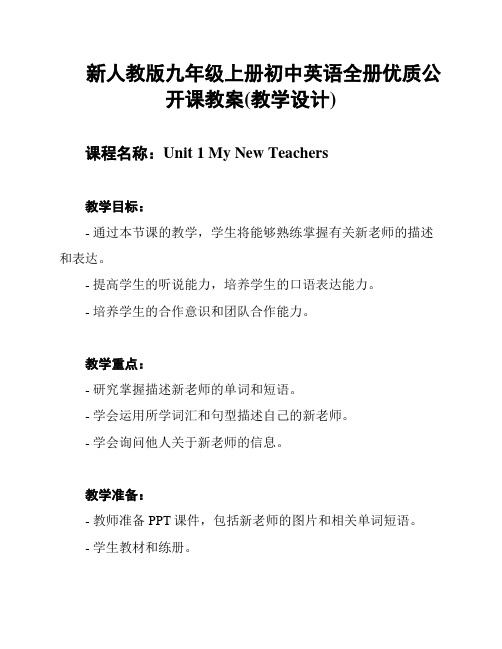
新人教版九年级上册初中英语全册优质公开课教案(教学设计)课程名称:Unit 1 My New Teachers教学目标:- 通过本节课的教学,学生将能够熟练掌握有关新老师的描述和表达。
- 提高学生的听说能力,培养学生的口语表达能力。
- 培养学生的合作意识和团队合作能力。
教学重点:- 研究掌握描述新老师的单词和短语。
- 学会运用所学词汇和句型描述自己的新老师。
- 学会询问他人关于新老师的信息。
教学准备:- 教师准备PPT课件,包括新老师的图片和相关单词短语。
- 学生教材和练册。
教学过程:1. 预导入:- 让学生在教材中找到与新老师相关的对话和信息,引发学生对新老师的讨论。
2. 新课呈现:- 通过PPT呈现新老师的图片,引导学生观察,激发学生对新老师的兴趣。
- 教师朗读并板书相关单词和短语,如:funny, strict, kind, teach, subject, etc.- 帮助学生理解这些词汇的含义和用法。
3. 听力训练:- 播放教材中与新老师有关的录音,要求学生仔细听,并回答问题。
- 教师带领学生讨论录音内容,检查学生对听力材料的理解。
4. 口语表达:- 学生们分组进行合作活动,每组选择一位组员描述自己的新老师,其他组员根据描述的特点猜测是哪位老师。
- 教师在每组间转动,观察学生的口语表达和合作情况,提供必要的指导和帮助。
5. 互动交流:- 分角色进行对话练,有几个学生扮演新老师的角色,其他学生通过提问的方式了解新老师的信息。
- 教师引导学生运用学到的句型和表达方式进行对话,确保每个学生都有参与。
6. 总结反思:- 教师和学生一起总结本节课所学到的词汇、短语和句型。
- 学生们分享本次合作活动的感受和收获。
课后作业:- 完成练册上与新老师相关的练题。
- 列表格,描述自己的新老师,并写出自己对他(她)的评价。
教学延伸:- 学生可以扩展口头表达,介绍其他教师或家人的特点和评价。
- 学生可以编写一段短文,描述自己的梦想老师。
最新人教版九年级上册英语全册教案.doc
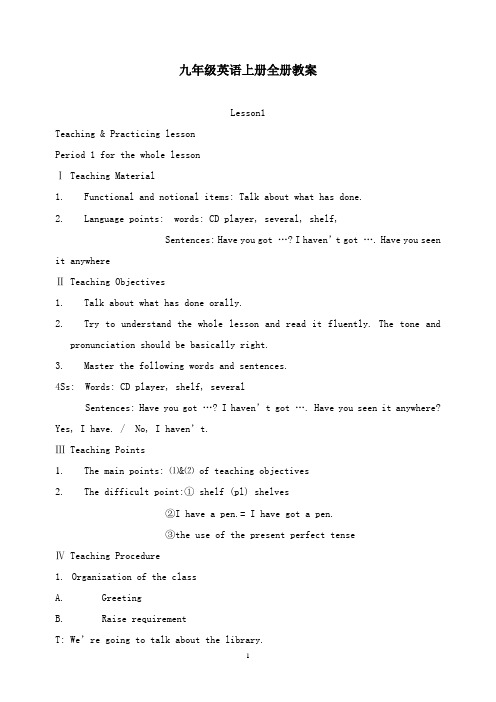
九年级英语上册全册教案Lesson1Teaching & Practicing lessonPeriod 1 for the whole lessonⅠ Teaching Material1.Functional and notional items: Talk about what has done.nguage points: words: CD player, several, shelf,Sentences: Have you got …? I haven’t got …. Have you seen it anywhereⅡ Teaching Objectives1.Talk about what has done orally.2.Try to understand the whole lesson and read it fluently. The tone andpronunciation should be basically right.3.Master the following words and sentences.4Ss: Words: CD player, shelf, severalSentences: Have you got …? I haven’t got …. Have you seen it anywhere? Yes, I have. / No, I haven’t.Ⅲ Teaching Points1.The main points: ⑴&⑵ of teaching objectives2.The difficult point:① shelf (pl) shelves②I have a pen.= I have got a pen.③the use of the present perfect tenseⅣ Teaching Procedureanization of the classA.GreetingB.Raise requirementT: We’re going to talk about the library.2.ReviewA.OralT: Do we have a library in our school? What do we have in the library? What can we do in the library?3.The teaching of the new lessonLesson 1T: Let’s learn Unit 1 In the library, Lesson 1. (write down the title) Teach: Have you got …?T: If you want to borrow a history book from the library, what do you say? Ss: Excuse me, do you have a history book?T: Yes, and we can also say: Have you got a history book?Write down the new sentence and compare the new one and the old one. Then teach the negative form and simple question form.And make more examples.Examples: He has got a good pen.They haven’t got any water.Our school has got a lot of students.B、Teach: Part 1T: Have you got a ruler? S1: Yes, I have. Here you are.T: Have you got an umbrella? S2: Sorry, I haven’t. Ask …Ask the Ss to use Part 1 to make new dialogue in pairs and then ask some to do it in front of the class. Teach “ CD player” at the same time.B.Teach: severalT: Have you got a pen? How many pens have you got?S1: FiveT: We may also say: “You’ve got several pens.”Write down the word: severalB.Teach: shelfT: Just now we talked about the library, we know there are many books in the library. Where are the books put?Teach: on the shelf shelf (pl) shelvesB.Part2T: Now I’d like you to make a dialogue talking about borrowing books about different subjects.Do it in pairs first then ask some to do it.Analysis: books about … at the moment = now = right nowB.Part 3Dialogue 1Listen and answer: Well, when you borrow books from the library, you must be careful, but Jim is not careful.What happened? Where was the book?Then read it and learn the dialogue.Analysis: Have you seen it anywhere? ( tense and the use of anywhere)Dialogue 2Listen and answer: How about Tom? What has he lost? Where was it? Read and learn.Analysis: have lost (tense)Perhaps he’s seen it. ( ‘s is short for has)I saw it on Lin Tao’s desk five minutes ago. ( tense)B. Conclusion1. have got = have 2 several = a few 3.on the shelf 4. the present perfect tenseA.Wb. Ex1 &24.Homework1.Do Wb. Ex 3&42.Recite Part 3Lesson 2Reading lesson2 periods for Lesson 2ⅠTeaching Materialsnguage points:Words: already, yard, schoolyard, step, librarian, probably, pay, sadly, mark, bookmarkPhrases: used to, put down, pay for, come up withSentences: Her hobby is reading.So was the librarian.Now her lost books are usually returned to the library.ⅡTeaching Objectives1.Read the whole lesson and try to understand its content. Make sure to answerthe questions in Wb correctly.2.Read the lesson fluently, the pronunciation and tone should be right.Ⅲ Teaching Points1.The main points---(1)&(2) in teaching objectives2.The difficult pointsA: already, “al” makes an / / soundB: the difference between “on” and “about”C: make sb. + adj.D: used to do sth.E: come up with an idea= think of an ideaPeriod 1Ⅳ Teaching Procedureanization of the classT: Today we are going to Lesson 2, in Lesson 2, we are going to talk about the library.2.ReviewT: Before we learn the new lesson, let’s go over what we learned yesterday.A.OrallyHave = have got eg. They don’t have any shelves.= They haven’t got any shelves. Has = has got eg. Does he have a CD player?= Has he got a CD player? Several=a fewOn the shelfThe construction and concept of the present perfect tenseB.Recite Part 2C.Wb. Ex33.The teaching of the new lessonA.Lesson 2T: We know we can borrow books from a library. But if we lose the books, what should we do? Let’s go on to learn Lesson 2, we will know the answer in it.( write down Lesson 2)B.pay forWell, you should pay for it.Teach: pay, paid, paidPay for : give money to sb. for sth.C.onT: Why do people like to go to the library?T: Because there are books on many different subjects.D.knowledgePeople can learn much knowledge from them.E.Part 1 Pre-readF.Part 2Ask the Ss the read the passage and answer questions in their Wb. Ex 1 G.Read and learnParagraph 1T: How old is the writer’s grandma?What was she?What is her hobby?Why does she love books?4.Homework.A. Read the end of the text and finish the exercises in Wb.Junior English for ChinaBook 3Lesson 3课型:讲练课ⅠTeaching Materials1.Functional and notional itemsAsk questions about something has donenguage MaterialsWords: encourage, once, abroad, copyPhrases: think of, encourage sb. to do sth., get sth. back, pick up Sentences: Have you ever been abroad? Yes, just once.I’ve just cleaned the kitchen.Really? I did that hours ago.Grammar: The difference between the present perfect tense and the past indefinite tenseⅡTeaching Objectives1.Learn to ask questions about something has done2.Read the whole lesson fluently, and pronunciation and intonation should beright.3.Master the following materials(4 skills) Words: once, copyPhrases: think of, pick upSentences: Have you been abroad? Yes, only once.(3 skills) Words: encourage, abroadPhrases: get sth. back, be abroadⅢ Teaching Points1.The main points: (1)&(2) in teaching objectives2.The difficult points:A.“ever, just, already”, they should be put in the middle of “ havedone”B. The difference between the present perfect tense and the past indefinite tense Ⅳ Teaching Procedureanization of the class2.RevisionBefore we go on to learn the new lesson, let’s go over what we learn in Lesson2.A.OralGrandma lost library books. If she really lose them, what should she do?Did the librarian have any ideas? What is it?What did they doB. Workbook Ex23.The teaching of the new lessonA.Lesson 3Can Grandma get all her lost books back? Let’s go on to learn Lesson 3.B.Read Part 1 and answer the following questions:Did Grandma get all her lost books back?How did she get them back?C.Read and learn*Think of:认为、想起、想出Eg: What do you think of it?I often think of my friends in Beijing.*Encourage sb. to do sth.Eg. The teacher thought a lot about how to encourage his students to study hard. *Pick up: pick it\them up*return sth. to sb.*get sth. from sb.D.Reading practiceE.Retell the storyF.Ask and answerHave you ever picked up a library book? Yes, I have\ No, I haven’t.Ask the students to ask and answer in pairs by using Part 2 and ask some to do it in class.Teach: abroad, onceDo Wb. Ex1G.Part 3Play and English songT: Have you ever listened to foreign music?Ss: Yes, we have.T: And we have just listened to it.Make sentences by using “ I have just…”Read and learnTeach: copyPoint out the difference between the present perfect tense and the past indefinite tense.The present perfect tense shouldn’t be used together with the past time.H.Conclusion●the use of “ever, just, already” in the present perfect tense ●the difference between the present perfect tense and the pastindefinite tense4.HomeworkA.Wb. EX2&3B.Go over the language pointsLesson 4课型:练习课ⅠTeaching Materialsnguage MaterialsWords: spoil, as, screenPhrases: on the computer, find outSentences: I guess somebody else has borrowed it.Could you find out who has taken it?Grammar: The present perfect tenseⅡTeaching Objectives4.Read the whole lesson fluently, and pronunciation and intonation should beright.5.Learn to read the information on the library cards and the computer screen.6.Master the following materials(4 skills) Word: asphrase: on the computer, find out(3 skills) Words: spoil, screenⅢ Teaching Points3.The main points: (1)&(2) in teaching objectives4.The difficult points: learn to read the information on the library cardsand the computer screenⅣ Teaching Procedureanization of the classToday, we are going to learn Lesson 4. In Lesson 4, we’re going to talk about the information on the library cards and the computer screen.6.RevisionBefore we go on to learn the new lesson, let’s go over what we learn in Lesson3.A.OralHow could Grandma get all her lost books back?the use of the adverbs in the present perfect tense.7.The teaching of the new lessonA.Lesson 4Yesterday, we learned that grandma usually borrowed books from the library. There is a new library today. If you want to read books, how can you find them? Let’s go on to learn Lesson 4.B.Part1I’d like you to listen and do Wb. Ex.1C.Part 2Ask the students to write down something about the school librarian and report it to the class. Teach: as He works there as a shop assistant.D.Part 4Learn to read the information on the cards and the computer screen.E.Part 3Listen and answer: What does the boy want to borrow?What’s its name?Who has borrowed it?Read and learn.has borrowed, has taken, has got( the present perfect tense)find outRead and act.F.Part 5Read and learn.G.Checkpoint 1H.Wb. Ex.2&58.HomeworkA.Wb. Ex 3B.Go over the whole unit.Lesson 5课型:讲练课ⅠTeaching Materials4.Functional and notional itemsA. Learn to ask how long sb. has done sth.B. Learn to talk about if someone has been to a place.nguage MaterialsWords: surf, surfing, surfer, wave, Hawaii, beach, twice, Bondi, none, Newquay, water-ski, canoePhrases: have a try, since last Wednesday, learn sth. from sb. how to do it, several timesSentences: What’s …like?How long have you been in Sydney?Have you ever been to …?Grammar: the present perfect tenseⅡTeaching Objectives7.Learn to ask questions about something has done8.Read the whole lesson fluently, and pronunciation and intonation should beright.9.Master the following materials(4 skills) Words: surf, surfing, surfer, wave, beach, twice, nonePhrases: have a trySentences: Have you been to…? Several times.(3 skills) Words: water-ski, canoe(1 skill) Words: Hawaii, Bondi, NewquayⅢ Teaching Points5.The main points: (1)&(2) in teaching objectives6.The difficult points:A.“ever, just, already”, they should be put in the middle of “ havedone”B. The difference between the present perfect tense and the past indefinite tense Ⅳ Teaching Procedureanization of the classToday, we’re going to talk about water sports.2. RevisionRevise the names of the sports they have learnt: roller-skating, skating, jump, race, skiing.10.The teaching of the new lessonA.Lesson 5And swimming is a kind of water sport because you have to swim in the water. Well, what other water sports do you know? Let’s go on to learn Unit 2 Water sports.e colour page1 to teach: surf, surfing, surfer, wave, water-skiing,canoe.C.Part 1Listen and answer: Who can surf, Ted or Bruce?How long has Bruce been in Sydney?Why did he come to Sydney?Who teach Bruce to surf?Read and learn:What’s …like? = How is …?Since last WednesdayLearn sth. from sb.Have you ever been to …?Have a tryHow to do itD.Read and act.E.Part 2Have you ever surfed?Have you ever been to Hawaii?Ask and answer in pairsLearn: Bondi, Cape Town, Newquay, noneNo one 人单数 No one is herenone 人/物单数/复数 None of them is here.F.Wb. Ex3. 2 . 1 .G.ConclusionSurf, surfing, surfer, waveHe’s a surfer. Have a tryHow long have you been in …?Have you ever been to …?11.Homeworkwb. Ex 2P.S.The writing on the blackboardUnit 2 Water sportsLesson 5surf ①What’s …like? = How is …? Have a try surfing ②How long have you been in …? learn sth. from sb.surfer Since last Wednesday no one 人/ 单wave ③Have you ever been to …? none人/物单/复Hawaii ④None of us has. none of us (true)Cape Town No one has. no one of us (false)Lesson 6ⅠTeaching MaterialsWords: describe, especially, attract, so-called, possible, since, part-time, although, fit, prize, competition, event, Olympic, Waikiki, Honolulu, SanFranciscoPhrases: all over, large numbers of, no matter, both…and…, give up, ever since, the Olympic GamesSentences: Now it is enjoyed by people all over the world.You can always find surfers out riding the waves.In the morning, he works as a part-time assistant in a surf shop. ⅡTeaching Objectives1.Try to understand the whole passage and read the whole lesson fluently andthe pronunciation and intonation should be right.2.Master the following materials:4Ss Words: describe, especially, attract, so-called, possible, since, part-time, although, fit, prize, competition, event, OlympicPhrases: all over, large numbers of, no matter, both…and…, give up, ever since, the Olympic GamesSentences: Now it is enjoyed by people all over the world.You can always find surfers out riding the waves.In the morning, he works as a part-time assistant in a surfshop.3.Master the following materials:3Ss Words: Waikiki, Honolulu, San FranciscoⅢ Teaching Points1.The main points: (1) &(2) in teaching objectives2.The difficult points: A. the use of “although” B. the use of “no matter”C. the use of “ both…and…”Ⅳ Teaching ProcedurePeriod 1anization of the classTalk about surfing2.ReviewHave you ever been to Qingdao?Who has ever been to Bondi Beach? None of us.Has anybody water-skied before? Nobody has.3.The teaching of the new lessonA.Lesson 6In Lesson 5, we learned some water sports. Today, we are going to talk about oneof them----surfing.B.Talk about surfingWhere is the best place for surfing? Why?Have you ever watched people surf?What do you think of it?Ask the students to say something about it.Teach: fit, prize, competitionSurfing will make you fit( healthy). Maybe you can take part in a surfing competition, then you may win a prize.Part 1 Pre-read Ask and answer then teach: watch sb. do sth.; describe sth.C.Part 2Read and do wb. Ex.1D.Conclusion.fit, win a prize4.HomeworkA.Go over what we learn todayB.Read the passage and find out all the new words, try to guess theirmeaning.Period 2Teaching Procedureanization of the classLearn the passage2.ReviewWatch sb. do sth.; fit(healthy); win a prize3.The teaching of the new lessonA. Paragraph 1Find out the key sentence. Then learn the new language points.one of…; be enjoyed by sb.; all over the world= everywhere in the world; be famous for\ as; especially; attract sb. to somewhere; large numbers of people(it is used to modify countable nouns)= a number ofRead this paragraph after the tape and then read it together. Ask some to read it in classB. Paragraph 2Find out the key sentence. Then learn the new language points..Read this paragraph after the tape and then read it together. Ask some to read it in classC.Paragraph 3Find out the key sentence. Then learn the new language points.D.Paragraph 4Find out the key sentence. Then learn the new language points.E.Conclusion4. HomeworkA.Wb. Ex. 2&3B.Retell the storyLesson 7课型:讲练课ⅠTeaching Materials1.Functional and notional itemsLearn to talk about something has donenguage materialsWords: such, fail, practice, New Zealand, businessPhrases: such great fun, on business, so farSentences: Time flies!He’s gone to New Zealand on business.ⅡTeaching Objectives1.Learn to talk about something has done.2.Try to understand the content and read the dialogue fluently, thepronunciation and intonation should be right.3.Master the following materials:4 skills Words: such, fail, practice, businessPhrases: so far, on businessSentences: He’s gone to …4.Master the following materials:2 skills Words: New ZealandⅢTeaching Points1.The main points: (1) & (2) in teaching objectives2.The difficult pointsA.such great funsuch+adj. +n.(不可数/复数)such a + adj. + n.(可数名词单数)与 so的区别B.have been surfingC.practice sth.\ doing sth.D.gone to & been togone to去了,强调不在说话地点been to 去过,强调对某地有所了解,可以在说话地点ⅣTeaching Procedureanization of the classWe are going to talk about Bruce and Ted again. In grammar, we are going to talk about the present perfect tense.2.RevisionA.Retell the story in Lesson 6.B.Wb. Ex2&33.The teaching of the new lessonA.Lesson 7In lesson 5, we know Bruce will show Ted how to surf. Can Ted surf now?B.Listen and answerCan Ted surf? What has Bruce been doing every day? Why?When is Ted leaving for home?How about Bruce?Where is Bruce’s uncle?C.Read and learnTeach: *on Bondi Beach*such great fun: very funnysuch+adj. +n.(不可数/复数) such beautiful flowerssuch a + adj. + n.(可数名词单数) such a beautiful flowerso+ adj. So beautiful a flower如果在数量词“many, much, few, little”前,要用“so”eg: so much water, so many people* fail (in) the examfail to do sth.=can’t do sth.eg: fail the exam=not pass the examfail to catch the bus= miss the bus* need more practicepractice: 练习,实践(为不可数名词)如: Practice makes perfect.Practice : 练习(为及物动词)如:practice doing sth.* Time flies.* gone to去了,强调不在说话地点been to 去过,强调对某地有所了解,可以在说话地点eg: Where is he? He’s gone to his home.* on businessD.Reading Practice.E.Part 2 Ask and answeryet 用于否定句,一般疑问句及条件状语从句already用于肯定句,如果用于一般疑问句则表示惊讶的语气F.Answer the questions in groups. Teach: so far: up to now Ask some to do it in classG.ConclusionH.Wb. Ex 14.HomeworkA.Recite Part 1B.Go over the whole lessonLesson 8课型:练习课ⅠTeaching MaterialsWords: cross, channel, mainland, slow, journey, among, proud, pride, unless, shot, truthPhrases: come true, slow down, be proud of, speak highly of, not only…but also… Sentences: Among them were his parents.He is not only the pride of our school, but also the pride of all the people in Hainan.ⅡTeaching Objectives1.Read the passage in Part 3 and try to understand its meaning. Read it fluentlyand the pronunciation and intonation should be right.2.Finish all the exercises in this lesson.3.Master the following materials as four skills:Words: cross, channel, mainland, slow, journey, among, proud, pride, Phrases: come true, slow down, be proud of, speak highly of, not only…but also…Sentences: Among them were his parents.He is not only the pride of our school, but also the pride of all thepeople in Hainan.4. Master the following materials as three skills: words: unless, shot, truth ⅢTeaching Points1.The main points: (1) & (2) in teaching objectives2.The difficult points: not only…but also…如果连接两个主语时,用就近一致原则。
人教版九年级上册英语教案(优秀5篇)
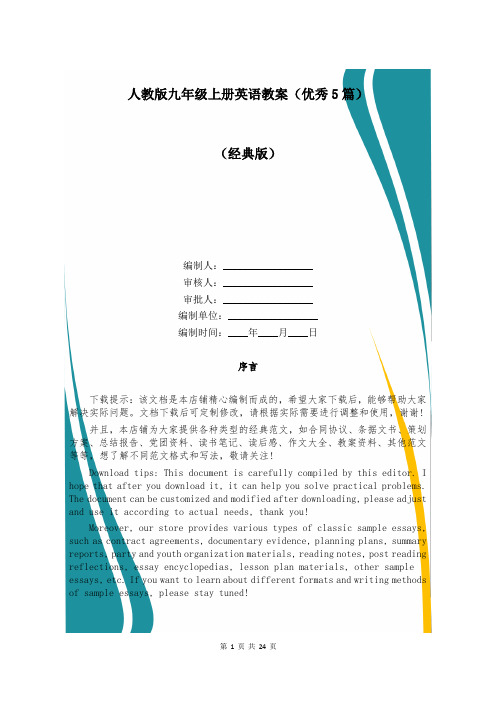
人教版九年级上册英语教案(优秀5篇)(经典版)编制人:__________________审核人:__________________审批人:__________________编制单位:__________________编制时间:____年____月____日序言下载提示:该文档是本店铺精心编制而成的,希望大家下载后,能够帮助大家解决实际问题。
文档下载后可定制修改,请根据实际需要进行调整和使用,谢谢!并且,本店铺为大家提供各种类型的经典范文,如合同协议、条据文书、策划方案、总结报告、党团资料、读书笔记、读后感、作文大全、教案资料、其他范文等等,想了解不同范文格式和写法,敬请关注!Download tips: This document is carefully compiled by this editor. I hope that after you download it, it can help you solve practical problems. The document can be customized and modified after downloading, please adjust and use it according to actual needs, thank you!Moreover, our store provides various types of classic sample essays, such as contract agreements, documentary evidence, planning plans, summary reports, party and youth organization materials, reading notes, post reading reflections, essay encyclopedias, lesson plan materials, other sample essays, etc. If you want to learn about different formats and writing methods of sample essays, please stay tuned!人教版九年级上册英语教案(优秀5篇)九年级是整个初中阶段的重要一年,因此教师需要学习先进的教育理念,认真准备每一次教案。
新人教版九年级英语上册全册教案
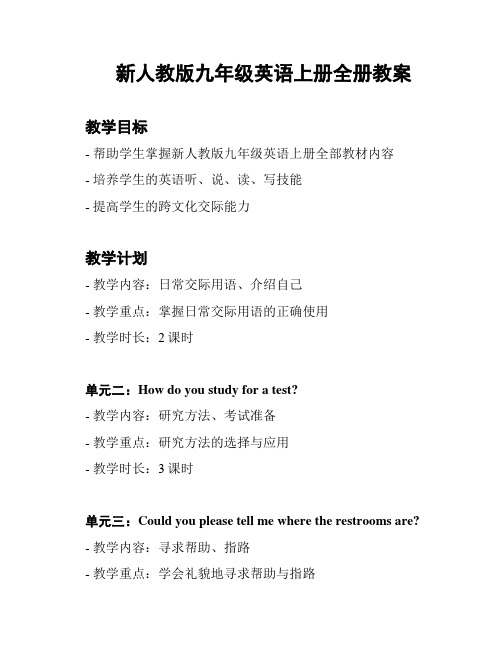
新人教版九年级英语上册全册教案教学目标- 帮助学生掌握新人教版九年级英语上册全部教材内容- 培养学生的英语听、说、读、写技能- 提高学生的跨文化交际能力教学计划- 教学内容:日常交际用语、介绍自己- 教学重点:掌握日常交际用语的正确使用- 教学时长:2课时单元二:How do you study for a test?- 教学内容:研究方法、考试准备- 教学重点:研究方法的选择与应用- 教学时长:3课时单元三:Could you please tell me where the restrooms are? - 教学内容:寻求帮助、指路- 教学重点:学会礼貌地寻求帮助与指路- 教学时长:2课时单元四:I used to be afraid of the dark.- 教学内容:过去的经历和惯- 教学重点:掌握过去式的使用- 教学时长:2课时单元五:What are the benefits of going green?- 教学内容:环境保护、可持续发展- 教学重点:理解环境保护的重要性- 教学时长:3课时单元六:I love music that I can dance to.- 教学内容:音乐、电影与艺术- 教学重点:学会表达自己对音乐、电影和艺术的喜好和感受- 教学时长:2课时单元七:Teenagers should be allowed to choose their own clothes.- 教学内容:青少年的权利与责任- 教学重点:理解和讨论青少年应有的权利与责任- 教学时长:3课时单元八:Reading for pleasure- 教学内容:阅读和写作- 教学重点:培养学生的阅读兴趣和写作能力- 教学时长:4课时单元九:Wildlife protection- 教学内容:野生动物保护- 教学重点:了解野生动物保护的重要性,并表达自己的看法- 教学时长:2课时单元十:Musical instruments- 教学内容:乐器与音乐- 教学重点:了解各种乐器和音乐类型,并能进行简单的介绍- 教学时长:3课时教学评价- 结合课堂表现、作业成绩、测试等多种评价方式进行评价- 通过个人表现、小组合作等方式培养学生的主动研究能力- 鼓励学生参与课堂互动,提高口语表达能力参考资料- 教材:新人教版九年级英语上册- 辅助教材:听力材料、课外阅读材料等。
最新 人教版九年级 英语上册全册教案

最新人教版九年级英语上册全册教案第一课时
教学目标
- 研究并掌握单词:hello, hi, goodbye, bye, nice to meet you
- 能够用英语进行简单的自我介绍和问候
- 熟悉并能正确使用句子:Hello, I'm [name]. Nice to meet you. 教学重点
- 研究常用的问候语和自我介绍方式
- 练口语表达能力
教学准备
- 教材《人教版九年级英语上册》
- 教学PPT
教学步骤
1. 导入新课,向学生简要介绍本节课的内容,并激发学生研究
的兴趣。
2. 分发教材,让学生跟读单词:hello, hi, goodbye, bye, nice to meet you。
3. 解释单词的意思,帮助学生掌握词汇。
4. 利用示范和展示图片等方式,让学生理解并掌握句子:Hello, I'm [name]. Nice to meet you.
5. 引导学生进行口语练,让他们用所学内容进行自我介绍和问候。
6. 收集学生的口语表达,进行点评和纠正。
7. 结束本节课,作简单复,并布置下节课的预内容。
教学延伸
- 练更多的问候语和自我介绍方式,丰富学生的口语表达能力。
- 制作小组或角色扮演活动,让学生在真实情境中运用所学内容。
教学评价
- 观察学生的参与程度和口语表达能力,及时给予鼓励和指导。
- 收集学生的口头回答、书面练习,进行评估和改进教学策略。
人教版九年级上册英语教案5篇
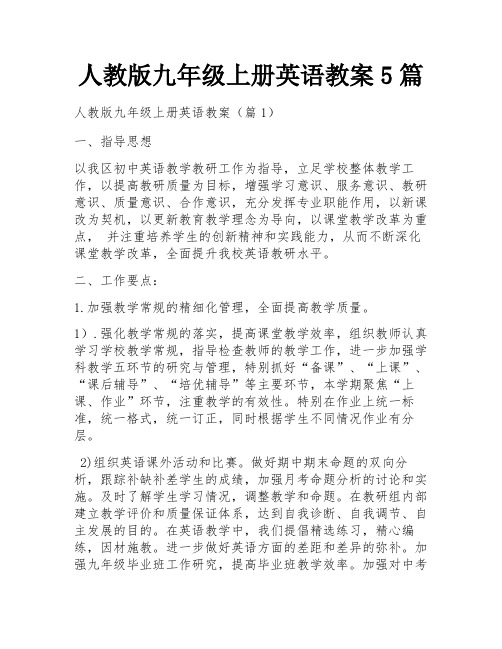
人教版九年级上册英语教案5篇人教版九年级上册英语教案(篇1)一、指导思想以我区初中英语教学教研工作为指导,立足学校整体教学工作,以提高教研质量为目标,增强学习意识、服务意识、教研意识、质量意识、合作意识,充分发挥专业职能作用,以新课改为契机,以更新教育教学理念为导向,以课堂教学改革为重点,并注重培养学生的创新精神和实践能力,从而不断深化课堂教学改革,全面提升我校英语教研水平。
二、工作要点:1.加强教学常规的精细化管理,全面提高教学质量。
1).强化教学常规的落实,提高课堂教学效率,组织教师认真学习学校教学常规,指导检查教师的教学工作,进一步加强学科教学五环节的研究与管理,特别抓好“备课”、“上课”、“课后辅导”、“培优辅导”等主要环节,本学期聚焦“上课、作业”环节,注重教学的有效性。
特别在作业上统一标准,统一格式,统一订正,同时根据学生不同情况作业有分层。
2)组织英语课外活动和比赛。
做好期中期末命题的双向分析,跟踪补缺补差学生的成绩,加强月考命题分析的讨论和实施。
及时了解学生学习情况,调整教学和命题。
在教研组内部建立教学评价和质量保证体系,达到自我诊断、自我调节、自主发展的目的。
在英语教学中,我们提倡精选练习,精心编练,因材施教。
进一步做好英语方面的差距和差异的弥补。
加强九年级毕业班工作研究,提高毕业班教学效率。
加强对中考走势的信息收集和测试研究,集中精力,争取在九年级中考中取得一个满意的成绩。
2.?以教科研引领,为教师的专业化成长打造新的平台。
1).大力开展校本教研,拓宽教师课程视野,逐渐成为学习型、反思型教师。
通过同伴互动。
充分发挥学校骨干教师、优秀教师的作用,通过“共享式的集体备课”、“探究式的课堂实践活动”和“专题式的学习讨论活动”等促进教师之间的互动,营造“集体备课、资源共享、个人加减、教后反思”的教研氛围。
结合优质课堂活动,并且推出一节具有代表性的研讨课。
(陈美红老师开课)2).根据各年级特点,进行一次主题教研活动。
Unit2SectionB(2a—3b)教案2023-2024学年人教版英语九年级全册

教学反思
本节课的主题是《Unit 2 Section B (2a—3b)》,我们学习了描述节日习俗的相关内容。通过本节课的学习,我希望学生能够掌握描述节日习俗的基本词汇和短语,了解一般现在时态的被动语态结构,并能够运用这些知识和技能进行有效的英语交流。
答案:My favorite holiday tradition is spending time with my family. We always have a big dinner together and exchange gifts. It's a time to appreciate each other and celebrate our love.
此外,在组织实践活动时,我鼓励学生进行分组讨论和角色扮演,这有助于提高他们的合作能力和口头表达能力。学生通过讨论和角色扮演的方式,能够更好地理解和运用描述节日习俗的词汇和短语。这表明,通过实践活动的方式能够有效地提高学生的实际运用能力。
最后,在总结回顾时,我强调了学生需要掌握描述节日习俗的基本词汇和短语以及一般现在时态的被动语态结构。我希望学生能够通过本节课的学习,能够更好地理解和运用这些知识和技能。
C. He says it's a time to eat a big meal.
D. He says it's a time to celebrate the New Year.
答案:B
5.题型五:写作题
题干:根据题目要求,写一篇短文。
例题:Write a short paragraph describing your favorite holiday tradition.
人教版九年级英语全册教案4篇
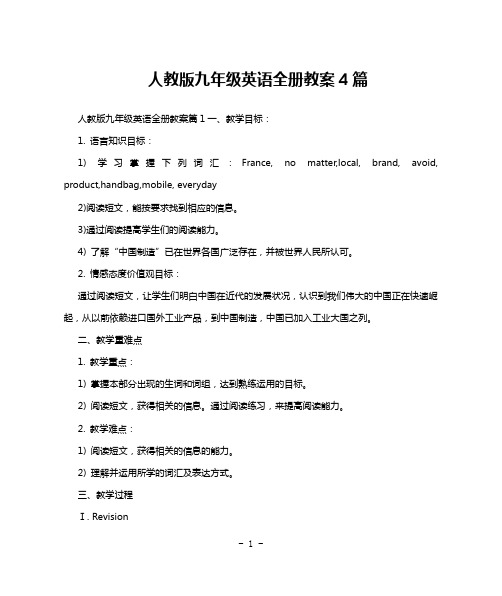
人教版九年级英语全册教案4篇人教版九年级英语全册教案篇1一、教学目标:1. 语言知识目标:1) 学习掌握下列词汇:France, no matter,local, brand, avoid, product,handbag,mobile, everyday2)阅读短文,能按要求找到相应的信息。
3)通过阅读提高学生们的阅读能力。
4) 了解“中国制造”已在世界各国广泛存在,并被世界人民所认可。
2. 情感态度价值观目标:通过阅读短文,让学生们明白中国在近代的发展状况,认识到我们伟大的中国正在快速崛起,从以前依赖进口国外工业产品,到中国制造,中国已加入工业大国之列。
二、教学重难点1. 教学重点:1) 掌握本部分出现的生词和词组,达到熟练运用的目标。
2) 阅读短文,获得相关的信息。
通过阅读练习,来提高阅读能力。
2. 教学难点:1) 阅读短文,获得相关的信息的能力。
2) 理解并运用所学的词汇及表达方式。
三、教学过程Ⅰ. Revision1. Ask Sstorole-play the conversation in 2d.2. Checkthehomework. Let some Ss tell read their sentences.(1). This ringismade of silver.(2). This kindofpaper is made from wood.(3). What ispaintmade from?(4). Hang Zhouisfamous for tea.(5). As far asIknow, tea plants are grown on the sides of the mountains.Ⅱ. Lead in1. 展示一段伦敦奥运会礼品的视频,让学生了解中国制造已被世界人民所接受。
Then ask Sssomequestions:T: As we know,thereare so many things made in China in England. What about in America andothercountries in the world? Now let’s read the passage of 3a.First, readquickly and find the answer to this question:1) Where did KangJianvisit last year?2) Were theremanythings made in China in the US?3) What twothingsdid Kang Jian want to buy in the US?4) Where weretheymade?Ss read thearticlequickly and try to answer the questions:2. 方法指导:带着问题,然后快速阅读短文,争取在较短的时间内,找到答案。
人教版九年级上册英语教案(优秀8篇)

人教版九年级上册英语教案(优秀8篇)作为一位兢兢业业的人民教师,总归要知道如何编写一份优秀的教案。
这次为您整理了8篇《人教版九年级上册英语教案》,亲的肯定与分享是对我们最大的鼓励。
九年级上册英语教案篇一一、教学内容本课是第二单元的最后一课,阅读课,是本单元话题过去的某种状态的延伸和继续。
文章讲得主要内容是一个老是惹麻烦的男孩在明白了母亲对他的爱之后变成一个好孩子的故事。
二、教学目标⑴掌握一些主要的词汇和句型used to be like 等。
⑴引导学生理解课文内容,掌握阅读技巧,如扫读、细读、概括文章大意,利用上下文信息猜词等。
⑴通过阅读课文,并设计各种活动训练学生运用英语进行听说读写各种活动的能力。
⑴激发学生感恩父母,热爱父母,关注身边的人的情感。
三、教学重点和难点⑴训练学生利用上下文信息填写词汇和句子的能力。
⑴培养学生的阅读策略和写作能力。
⑴利用本课所学知识表达个人意见,对课文进行深层理解。
四、设计理念依据纽南(David Nunan)所提出的任务型及合作式教学原则,使学生在小组学习中获取信息,处理信息和运用信息,激发学生用所学语言进行交际的愿望和自信心,促进合作精神和文化意识的发展。
五、教学设计1. 总体思路:本节课是在多媒体的课堂教学环境下实施的大容量、快节奏的课堂教学。
笔者先让学生简短描述父母以前和现在的职业,外貌,性格,爱好再欣赏英文歌曲thank you, dad. 导入,酝酿了一种感激父母的氛围,接着引导他们畅诉父母对自己的帮助的故事,然后让学生阅读短文,感受母亲爱的伟大。
在阅读过程中,通过让学生看标题,预测课文内容、概括文章段落大意、根据上下文填所缺的句子,判断正误等各种方式提高阅读技能。
最后,笔者提供关键词让学生复述课文,使其能熟练得掌握所学的重点词汇、短语和句子。
阅读后,笔者抛出这样的问题让学生讨论:我们该用什么方式报答父母?培养学生反哺意识。
最后通过写作,提高学生综合运用语言的能力。
人教初三上册英语教案

人教初三上册英语教案英语教学设计日臻精致、完美,行之有效和富于独创性,以极大地刺激学生的学习情绪,满足他们的学习欲求,构成师生之间和谐轻松愉快和谐的课堂氛围。
后面下面是整理的人教初三上册英语教案5篇,欢迎大家阅读分享借鉴,希望大家喜欢,也希望对大家有所能够帮助。
人教初三上册英语教案1教学目标1能够圈出相同的字母,熟练认读26个英文字母。
2数出文具单词的数量,听说认读AB部分Let’s learn的8个文具的单词:crayon,pencil,pen,eraser,ruler,bag,book,pencil-box。
教学重难点教学重点:1字母的认读;2听说认读8个文具的单词:crayon,pencil,eraser,ruler,bag,book,pen,pencil box。
教学难点:较准确读出各单词,尤其是crayon和eraser两个单词的发音。
教学工具ppt课件教学过程ⅠGreetingsT: Hello,boysand girls. Ss: Hello, Miss Ren.T: Hello,I’mMiss Ren. S: Hello,I’T: Hello,What’syour name? S: My name’sⅡPresentation1 I have somefriends.Let’s say hello to them.通过与字母招呼,复习26个字母。
2 We ha ve somany new friends. Are you happy? Let’s sing together.师生齐唱字母歌,复习巩固字母。
3 the letter“a”made some new friends.He has a show for us. 通过字母秀的形式引出文具单词,并通过短语Showme your Open your.... Close your.... Carry your....操练单词。
Ⅲ Drill1 The letter “a”is coming. Let’s help the letter find the same friends.教师先做例子,然后学生两人一组圈出师生相同的拉丁字母。
人教版九年级英语全册教案4篇
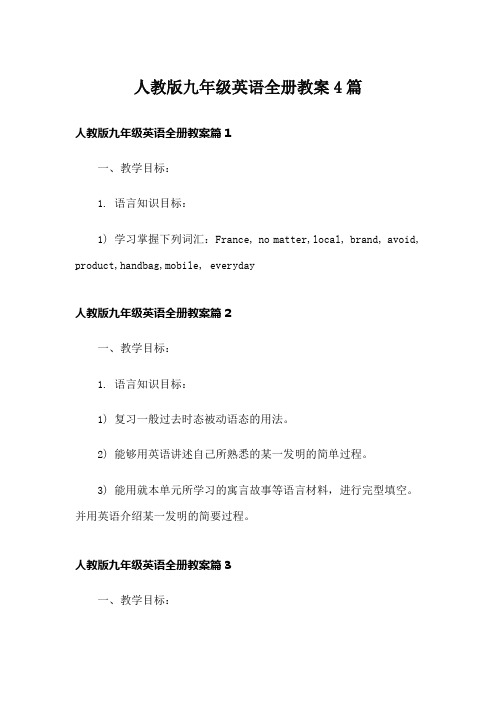
人教版九年级英语全册教案4篇人教版九年级英语全册教案篇1一、教学目标:1. 语言知识目标:1) 学习掌握下列词汇:France, no matter,local, brand, avoid, product,handbag,mobile, everyday人教版九年级英语全册教案篇2一、教学目标:1. 语言知识目标:1) 复习一般过去时态被动语态的用法。
2) 能够用英语讲述自己所熟悉的某一发明的简单过程。
3) 能用就本单元所学习的寓言故事等语言材料,进行完型填空。
并用英语介绍某一发明的简要过程。
人教版九年级英语全册教案篇3一、教学目标:1. 语言知识目标:1) 学习掌握下列单词和短语:block, in linewith, worker, stare, disbelief, above,burn, burning, alive, airport, till ,west2) 能掌握以下句型:Life is full oftheunexpected.I was about to goupwhen I decided to get a coffee first.As I was waitinginline with other office workers, I heard a loud sound.Before I coldjointhe others outside to see what was going on, the first plane had alreadyhit myoffice building.3) 进一步熟练掌握过去完成时的用法。
2. 情感态度价值观目标:1) 通过学习使学生认识到生活中充满着许多出乎预料的事件,培养学生正确看待事物的积极心态。
2)能运用所掌握的语法,句型和词汇进行交流。
3)能比较流利地讲述自己曾经有的特别的一天。
二、教学重难点1. 教学重点:1)掌握本课时中出现的生词block, in linewith,worker, stare, disbelief, above, burn, burning, alive, airport, till ,west2) 学会用过去完成时叙述自己曾经有的特别的一天。
人教版九年级全一册英语Unit1sectionA3a3b优秀教学案例
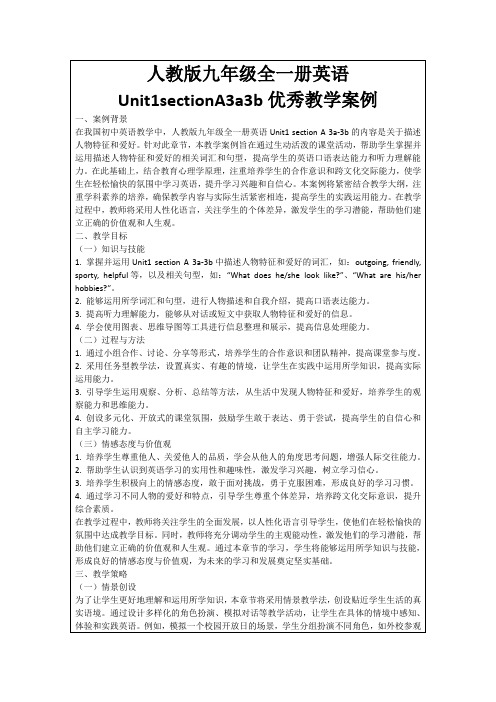
2.问题导向教学,激发学生思考与探究
3.小组合作学习,促进学生团队协作与沟通
小组合作学习在本案例中发挥了重要作用。学生分组进行讨论、分享,共同完成人物描述任务,培养了团队协作精神和沟通能力。同时,教师关注小组学习过程,给予及时指导和反馈,提高了小组合作学习的效率。
在教学过程中,教师将关注学生的全面发展,以人性化语言引导学生,使他们在轻松愉快的氛围中达成教学目标。同时,教师将充分调动学生的主观能动性,激发他们的学习潜能,帮助他们建立正确的价值观和人生观。通过本章节的学习,学生将能够运用所学知识与技能,形成良好的情感态度与价值观,为未来的学习和发展奠定坚实基础。
(三)小组合作
小组合作学习是本章节教学策略的重要组成部分。教师将根据学生的性格、能力和兴趣等特点,合理分组,确保每个学生都能在小组中发挥自己的优势。通过设置小组任务,如共同完成一个人物描述、进行小组讨论等,培养学生的团队合作意识和沟通能力。同时,教师应关注小组学习过程,及时给予指导和反馈,提高小组合作学习的效率。
1.培养学生尊重他人、关爱他人的品质,学会从他人的角度思考问题,增强人际交往能力。
2.帮助学生认识到英语学习的实用性和趣味性,激发学习兴趣,树立学习信心。
3.培养学生积极向上的情感态度,敢于面对挑战,勇于克服困难,形成良好的学习习惯。
4.通过学习不同人物的爱好和特点,引导学生尊重个体差异,培养跨文化交际意识,提升综合素质。
4.反思与评价机制,关注学生个体差异与成长
本案例强调学生自我反思和相互评价,使学生学会总结经验、找出不足,并在相互评价中学习他人的优点。这种机制充分关注了学生的个体差异,有助于促进学生的个性化发展和综合素质的提升。
新人教版初中英语九年级上册全册教案
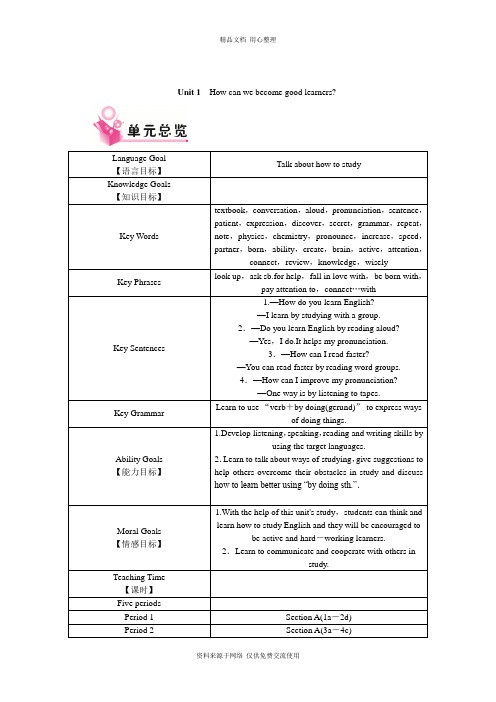
Unit 1How can we become good learners?Language Goal【语言目标】Talk about how to study Knowledge Goals【知识目标】Key Words textbook,conversation,aloud,pronunciation,sentence,patient,expression,discover,secret,grammar,repeat,note,physics,chemistry,pronounce,increase,speed,partner,born,ability,create,brain,active,attention,connect,review,knowledge,wiselyKey Phrases look up,ask sb.for help,fall in love with,be born with,pay attention to,connect…withKey Sentences1.—How do you learn English?—I learn by studying with a group. 2.—Do you learn English by reading aloud?—Yes,I do.It helps my pronunciation.3.—How can I read faster?—You can read faster by reading word groups. 4.—How can I improve my pronunciation?—One way is by listening to tapes.Key Grammar Learn to use “verb+by doing(gerund)” to express waysof doing things.Ability Goals 【能力目标】1.Develop listening,speaking,reading and writing skills byusing the target languages.2.Learn to talk about ways of studying,give suggestions to help others overcome their obstacles in study and discuss how to learn better using “by doing sth.”.Moral Goals 【情感目标】1.With the help of this unit's study,students can think and learn how to study English and they will be encouraged to be active and hard-working learners. 2.Learn to communicate and cooperate with others instudy.Teaching Time【课时】Five periodsPeriod 1 Section A(1a-2d) Period 2 Section A(3a-4c)Period 3 Section B(1a-1e)Period 4 Section B(2a-2e)Period 5 Section B(3a-3b) & Self Check本单元围绕学习的话题,讲述了学习的障碍及对应的解决方法,对学生的学习有重要意义。
人教版九年级英语上册教案全集

Unit 1 How do you study for a test?Page 2, 1a, 1b, 1c课时: Period 1教学目的: Talk about how to study.Learn the use of “by doing something”重点难点: Useful expressions-How do you study …? I study by doing …教学工具: courseware教学步骤:Step 1. Self-introductionThe new term has come. Ask the students to introduce themselves to the ot hers and the teacher. Then ask what they did in the summer holiday. If possible, ask how they did that.Help the students use the construction “I …by doing…”.Explain “by”. Step 2. DiscussionHave the students say what they think of English.Then tell each other how they study for an English test. See the phrases shown in the courseware, which is similar to 1a. Remind them to use “by doing…”Step 3. 1a. Checking the ways you studyAsk students to finish the task. They can add something else.Step 4. 1b.ListeningListen to the listening stuff of 1b, which is recorded in the courseware (convenient to be repeated). Finish the task.Then the teacher asks, ”How did Mei/ Pierre / Antonio study?” Have some students give the answers, i.e. repeat the sentences by using “by doing”Step 5. 1c. Making dialoguesWork in pairs or groups. Discuss first. Then make a short dialogue.Have the students share their work.Step 6. Writing.See the courseware. Fill in the blanks. Write down the answers on a piece of paper. Ask students to read their work.课时: Period 2教学内容: Page 3, 2a, 2b, 2c and the grammar focus.教学目的: Talk about how to learn English.Consolidate the use of “by doing something”重点难点: Useful expressions-Do you study …by doing…? Yes /No... (reason). 教学工具: courseware教学步骤:Step 1. RevisionMake a dialogue between the teacher and some students. Ask whether they like English, then tell the reason. Ask how they learn English.Step 2. 2a. ListeningSee the courseware. Explain any difficult points. Listen to the stuff, an d check the answers.Have students repeat some main sentences, ready to practice dialogues.Step 3. 2b.ListeningFinish the task.Step 4. 2c.Doing a pairworkGive students some time to talk about the contents of 1a and 1b.See the courseware. Some patterns will help, such as “Do you.../ What ab out.../ Have you ever.../ How do you…?” and the possible answers.Share their dialogues.Step 5. Make a conversation.Ask students to tell the others their own experience about studying Engli sh by working in pairs or groups. Then make a conversation respectively.The y can also use indirect speech, such as “... says she learns ... by ...”etc.Step 6. SummaryPoint out the main contents learnt these two days.英语(九年级)教学设计(3)课时: Period 3教学内容: Page 4, 3a, 3b,教学目的: Practice reading.Learn useful expressions.Practice writing.重点难点: v + ing phrase used as a subjectfind / think + O + OC教学工具: courseware教学步骤:Step 1. Make a statement.Firstly the teacher asks a student a question and the student answers. As k several.Then have many more students make a statement one by one to introduce how he / she learns English.Step 2. 3a. ReadingFirstly, read to the tape aloud. Pay attention to the pronunciation and t he intonation.Read again, underline the useful expressions.Read once more. Fill in the chart. Check the answers.Step 3. Learn the useful expressions.1. Ask students to say the useful expressions they have underlined.2. Add if the students miss some.3. Learn some grammar:Ask a student to tell us how many sentences, which include v-ing phrase as a subject, are in the text. Point out the constructions. Explain why they are use d.Tea ch the structure ”find / think + O + OC” and other grammar.Step 4. 3b. PairworkGive the students a little time to prepare a role play.Ask some to share their work with the whole class.Step 5. ConsolidationIn Chinese, teacher says some important phrases from the text. Have the student s tell us the English ones as quickly as possible.Unit 2 I used to be afraid of the dark.The First PeriodTeaching Contents: Section A 1a,1b,1c,2a,2b,2cStep I Organization of class1.Greeting2.Warming upStep II Presentation1.Words CompetitionShow the class many words of appearance and personality. Get them to put the words in the right place.2.Guess: Who is the boy?Show the class some information about Harry Potter:He is a boy. He is not tall. He has curly hair. He is easygoing. He is very smart. He can see strange things and so on.3.Show two photos of the teacher —five years ago/ now. Ask the students some questions: What did I look like five years ago? What do I look like now?4.Introduce the new conversations in Unit 2.I used to be fat. I am thin now.I used to have long hair. I have short hair now.I used to play basketball. I play ping-pong now.Step lIl Teaching Tasks1.Task One (Pairwork): Listening to the tape(1) Show the students two pictures and say something about the people in the picture.(2) Listen to the tape. Then fill in the blanks in lb,2a,2b.2.Task Two (Groupwork): Describing different persons(1) Show the students a set of pictures, such as a movie star, a sportsman,a teacher.(2) Get the students to discuss in groups and take notes, such as: Jacky Chan used to have big eyes, but now he has small eyes.(3) Ask two or three groups to present their answers.(4) Which group does best?3.Task Three (Team work): Survey(1) Ask the students to bring two photos of themselves to class.(2) Get the students to talk about the changes of their classmates and write down the key words in the form.(3) Let the team leader present their survey results.(4) Who has changed most in your team?(5) Which is the best team?Step IV SummaryStep V Assign homeworkWrite a composition about your classmate before and now.The Second Period Teaching Contents: Section A 3a,3b,4Step I Organization of class1.Greetings2.Singing an English songStep II Revision1.Revise the conversations that the students learned in the first period. Ask them to talk about some pictures.2.Check the homework. Talk about what one person used to be like and she/ he is like now.Step IIl Presentation1.Show the class a picture of a big dog,then introduce the new conversations in 3a:I used to be afraid of big dogs./I’m still afraid of big dogs.2.Ask the students some questions like this:What did you use to be afraid of?/Are you still afraid of...?Step IV Teaching Tasks1.Task One (Pairwork):Match the pictures with the phrases.(1) Show the students six pictures about the phrases in 3a.(2) Ask the students to talk about the pictures in pairs and match them.2.Task Two:Put checks in the first two columns.(1) Show the students the first two columns about “I”, then get them to put checks.(2) Ask a group of students to read out their answers like this:I used to be afraid of... / I’m still afraid of...3.Task Three(Pairwork):Put checks in the last two columns.(1) Show the students the last two columns about “My Partner”.(2) Get the students to practice the dialogs in 3b.(3) Put checks in the columns.(4) Ask several pairs to present their answers.(5) Choose the best pair.4.Task Four(Groupwork): A survey(1) Show the students a form about the activities.(2) Get the students to fill in the blanks about “I”.(3) Get the students to ask their classmates and fill in the blanks about “My classmate”.(4) Ask the students to ask questions like this:What did you use to eat?/ What do you eat now?(5) Let two or three groups present their results.(6) Which is the best group?5.Task Five (Teamwork): How has Zhongshan(中山)changed?(1) Show the class several pictures of Zhongshan city — Past and Now.(2) Get the students to talk about the pictures and write down the key words on the paper.(3) Ask two or three team leaders to present their opinions.Step V SummaryStep V IAssign homeworkGet the students to write a composition about“Zhongshan has changed a lot!”The Third Period Teaching Contents: Section B la, lb, 2a, 2b, 2c, 3aStep I Organization of classWarming upStep II Checking up the homework1.Ask two students to read out their compositions (Zhongshan has changed a lot!).2.Get students to discuss the compositions.Step III Presentation1.Show the class four pictures in la.2.Ask students to describe what is happening in each picture:A girl is exercising in gym class.A girl is painting a picture.A boy is singing.A boy is looking at some insects.3.Ask students to check the things they liked to do when they were very young.Step IV Teaching Tasks1.Task One (Pairwork): I used to like to...(1) Point out the lines under the picture in lb.(2) Ask students to write down different things that they used to like to do.(3) Get students to discuss the answers in pairs, then ask some students to read out their sentences.2.Task Two: Listening practice (2a, 2b)(1) Ask students to listen to a dialog between a boy and a girl.(2) Ask students to check the sentences on the list that they hear on the recording.(3) Check the answers in 2a.(4) Play the recording again. Ask students to fill in the blanks with the words they hear.(5) Correct the answers in 2b.3.Task Three (Pairwork): Making up dialogs(1) Teach students the conversation in 2c.(2) Say some sentences using Did you...?and the answers Yes, I did./ No, I didn't.(3) Ask students to make similar dialogs in pairs.(4) Call on different pairs to read out their conversations to the class.4.Task Four (Groupwork): A debate(1) Show students a survey that the teacher did before the class.(2) Get them to discuss their hairstyles in the past and now like this:I used to have ... hair, but now I have ... hair.(3) A debate──Should students choose their own hairstyle? Why or why not?5.Task Five: Reading Practice(1) Get students to read the story in 3a.(2) Ask students to complete the chart about Rose Tang then and now.(3) Check the answers.Step V SummaryStep VI Assign homework1.Ask students to Complete the letter in 3b (How I've changed!).2.Get students to talk to their parents and fill in the chart in 4a.The Fourth Period Teaching Contents: Section B 3b, 3c, 4a, 4b, Self Check.Teaching Procedures:Step I Organization of classStep II Checking up the homework1.Ask some students to read out the letter (How I've changed!).2.Get students to discuss their answers and choose the best one.Step lII Teaching Tasks1.Task One (Pairwork)Ask students to finish 4a before the class-Talk to their parents and fill in the chart in 4a.2.Task Two (Groupwork)(1) Ask students to talk about the contents in 4a with their classmates.(2) Choose two groups to present their answers.3.Task Three (Teamwork): How has Yu Mei changed!(1) Get students to talk about the pictures in Self Check 2.(2) Ask students to use the drills in Unit 2 to describe the pictures.(3) Ask students to write down a composition about Yu Mei on the paper.(4) Ask two or three of them to read out their compositions in class.(5) Choose the best one.4.Task Four (Teamw ork): A survey── How has our life changed?(1) Show students some information in Unit 2.(2) Ask students to talk about how their life has changed since primary school and fill in the blanks in the survey form.(3) Ask the team leaders to present their survey results.(4) Choose the best team.5.Task Five: A composition about the changes in our life(1) Get students to write a composition on the paper.(2) Ask students to exchange their compositions and correct them.(3) Show the class one or two good compositions.Step IV SummaryStep V Assign homeworkFinish Part One of Self Check.The Fifth PeriodReading—E-mail EnglishStep I Organization of class1.Ask the whole class some questions:What subjects do you study at school?What subject do you like best? Why?2.Talk about the usage and importance of English.Step II Introducing E-mail EnglishWhat does e-mail English mean? What is it used for?Step III Teaching Tasks1.Task One (Pairwork)(1) Ask students to talk about the words in Part 1.(2) Ask students to fill in the chart with their partners and try to think of some more.(3) Check their answers.2.Task Two: Matching(1) Get the students to read the whole article as quickly as they can.(2) Try to finish the exercise in Part 2—Match each paragraph with its main idea.(3) Check the answers.3.Task Three: Deep Comprehension(1) Tell the students to read the article more carefully again.(2) Try to finish the exercise in Part 3—Match the words and expressions with their meanings.(3) Try to finish the exercise in Part 4—Find words or phrases for 1-5.(4) Check their answers.4.Task Four (Pairwork)(1) Ask the students to finish Part 5 in pairs.(2) Write a message to their partner using the e-mail English in this reading or other e-mail words.(3) Let some students read out their e-mails.(4) Choose the best one.Step IV SummaryStep V Assign homeworkWrite a reply to your partner, using the e-mail English as much as possible Unit 3 Teenagers should be allowed to choose their own clothes.I. Learning objectives 教学目标SkillFocus Talk about what you are allowed to do.Learn to talk about “agree” and “disagree”.Talk about the rules around the students.Learn to make rules or change rules reasonably.LanguageFocus功能句式Talk about what you are allowed to do (P18)I think teenagers should be allowed to drive.Students should not be allowed to have part-time job.Talk about “agree” and “disagree” (P19)I think students should be …I disagree. They talk …I agree.Do you think …?No, I don’t.Talk about the rules (P20-22)We have a lot of rules …So do we.My friends and I goy to talk about the rules …What school rules do you think should be changed?词汇 1. 重点词汇license, silly, study, present, member, sleepy, reply, possibly, drop, final, count, owner, sky, catch, interview, noise, wind, neighbor, director, smell, finger, lift, stone2. 认读词汇pierce, earring, concentrate, design, opportunity, volunteer, local, mess, newsletter, obey, achieve, realistic, taught, Kathy3. 词组get in the way, care about, instead of, stay up, concentrate on, at present, old people’s homestay up, be strict with, the other day, learn from, at present, be good for, English-English Dictionary语法should + be allowed to do …StrategyFocus 1. Reflecting2. transforming informationCultureFocus What rules do they have at school/home?What school or other rules do you think should be followed /changed?II. Teaching materials analyzing and rearranging教材分析和重组1.教材分析本单元以Teenagers should be allowed to choose their own clothes 为话题,共设计了四个部分的内容:Section A该部分有4个模块:第一模块围绕What should teenagers be allowed to do? 这一话题展开思维(1a)、听力(1b)、口语 (1c) 训练;第二模块围绕“agrees” and “disagrees”进行听力(2a-2b)、口语 (2c) 训练,并就所学语言结构进行总结(Grammar Focus);第三模块就“about following the rules”这一话题展开阅读训练(3a)和角色表演训练 (3b) ; 第四模块继续就上一话题以小组活动形式展开讨论。
2023年版人教新目标九年级英语上册全册教案

2023版人教新目旳九年级英语上册全册教案Uuld you please tell me ware?一、教学目旳:语言知识目旳基本词汇:amp, bard, pardon, wabaal, rush, suggest, staff, graal, mail, east, fascinating, convall, cllite, politely, speaker, request, ddirect, whom, address, underground基本句型:Excuse me, do you know where I can budicine?Sure. There’s a supermarket dowuld you please tell me how to g?I’m not sure how to gI wonder where we should go nexuld you tell us wband starts playing this evening?You should try that new ride ov2. 技能目旳: (1)能用宾语从句礼貌旳寻求协助。
(2)能用对旳旳措施指路。
情感目旳: 培养学生尊重他人,对人有礼貌,热爱生活。
二、教学重难点:教学重点:(1)礼貌旳向他人寻求协助。
(2)对旳使用宾语从句。
2. 教学难点:运用宾语从句礼貌旳寻求协助。
三、教学环节:A 1 (1a-2d)Warming –uGreeting2 Presenta(1)Guessing gaw pictuwhole claudent explalagl ish and awho doesn’t look at the blackboard guesses what plaFor exampludent say: We can savxchanglace, agua bank. Get studgulaces like babuseum, bawaall and(2)Showaudents andw:uld you tell me where I can buamps?uld you please tell me where I can get a dictionary?Do you know where I can gagazines?Pra)Match each thing with a plaure in 1a.2)Reada___ g___ gaga___ have d___ get a dictionary ___ gation abouwn___ buy a newspa___ bua___ get a paListeningListen and complversaure in 1a. Tanswers wwhole claPraake conversations usingaa. Then talk about your owFor example:A: Excuuld you please tell me how to gb?B: Sure, just go along Mauntil you paThe bur right, beside the baA: Thanks. Do you know wbloses today?B: It closes at 7:00day.A: Thank you!B: You’re welListeningListen and number the dder that you hea2a You will headbelow. Number the dder you hea___ Gbird fl___ Turn l___ Gd fl___ Turn rig___ The supermabetwlowand the b___ Go past the b2. Listen again. Show how the boy walupermarket. Drawa lure in 2a. Then gudent draw the lblackboard.3. Ld time and answer the qu) Excuan you tell me whereI can budicine?2) Do you know how to go there?3) OK, great. Oh, andg. Do you know wglght?4) OK, thanks a lPairwake conversations aboulaure in 2a.A: Excuan you tell me where I can buamps?B:’s agA: Do you know how to go there?B: Yes. Gd floor and turn right. Then go past the bank. Tbetween museum and library. You should be able to get staA: O K, great. Oh, andg. Do you know …B: I’m not sure, but you …A: OK, thanks a lB: You’re welReadingReadversa2d and answer the qu2. Role –plaversaxplain the languag2d.(1) Go along Mauntil you pa) until和 till同义为“直到……” ,till多用于口语,until可以放在句首,till则不能放在句首。
2022-2023学年新人教版九年级上册英语全册教案
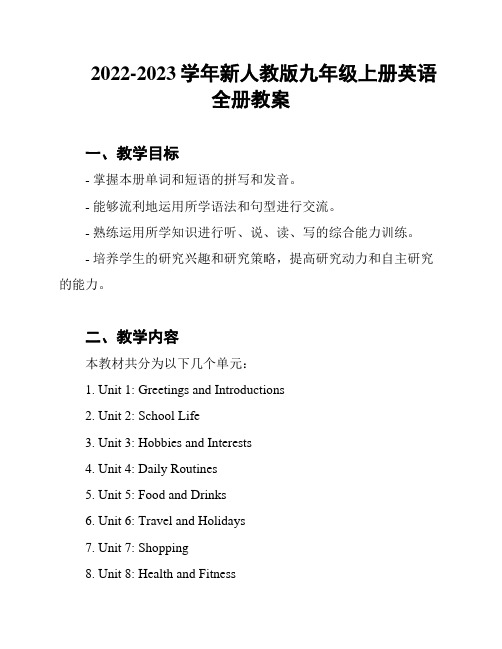
2022-2023学年新人教版九年级上册英语全册教案一、教学目标- 掌握本册单词和短语的拼写和发音。
- 能够流利地运用所学语法和句型进行交流。
- 熟练运用所学知识进行听、说、读、写的综合能力训练。
- 培养学生的研究兴趣和研究策略,提高研究动力和自主研究的能力。
二、教学内容本教材共分为以下几个单元:1. Unit 1: Greetings and Introductions2. Unit 2: School Life3. Unit 3: Hobbies and Interests4. Unit 4: Daily Routines5. Unit 5: Food and Drinks6. Unit 6: Travel and Holidays7. Unit 7: Shopping8. Unit 8: Health and Fitness9. Unit 9: Entertainment and Media每个单元包含以下几个部分:- Vocabulary:研究新词汇和短语,并进行拼写和发音练。
- Grammar:研究新的语法知识和句型,并进行相关练。
- Listening:进行听力训练,培养听力理解能力。
- Speaking:进行口语训练,提高口语表达能力。
- Reading:进行阅读训练,培养阅读理解能力。
- Writing:进行写作训练,提高写作水平。
三、教学方法- 任务型教学:通过任务设置,激发学生的研究兴趣和动力。
- 合作研究:鼓励学生进行小组合作,互相交流和研究。
- 多媒体辅助教学:利用多媒体资源来增强学生的研究效果。
- 游戏化研究:通过游戏和竞赛的方式来提高学生的研究积极性。
四、教学评估- 日常作业:布置练题和作文,检查学生的研究情况。
- 课堂表现:观察学生的参与程度和表现,评估其研究态度和能力。
- 随堂测验:进行小测验,检验学生对所学内容的掌握情况。
- 期末考试:进行综合性的考核,评估学生的研究成果。
- 1、下载文档前请自行甄别文档内容的完整性,平台不提供额外的编辑、内容补充、找答案等附加服务。
- 2、"仅部分预览"的文档,不可在线预览部分如存在完整性等问题,可反馈申请退款(可完整预览的文档不适用该条件!)。
- 3、如文档侵犯您的权益,请联系客服反馈,我们会尽快为您处理(人工客服工作时间:9:00-18:30)。
人教版九年级英语上册全册教案Unit 3 Could you please tell me where the restrooms are?一、教学目标:1. 语言知识目标基本词汇:restroom, stamp, bookstore, postcard, pardon, washroom, bathroom, normal, rush, suggest, staff, grape, central, mail, east, fascinating, convenient, mall, clerk, corner, polite, politely, speaker, request, direction, correct, direct, whom, address, underground基本句型:Excuse me, do you know where I can buy some medicine?down the street.Sure. There’s a supermarketCould you please tell me how to get to the post office?Sorry, I’m not sure how to get there.I wonder where we should go next.Could you tell us when the band starts playing this evening?You should try that new ride over there.2. 技能目标: (1)能用宾语从句礼貌的寻求帮助。
(2)能用正确的方法指路。
3. 情感目标: 培养学生尊重他人,对人有礼貌,热爱生活。
二、教学重难点:1. 教学重点:(1)礼貌的向他人寻求帮助。
(2)正确使用宾语从句。
2. 教学难点:运用宾语从句礼貌的寻求帮助。
三、教学步骤:Section A 1 (1a-2d)Step 1 Warming –upGreetingStep 2 Presentation(1)Guessing gameShow pictures to the whole class, one student explains the places in English and another one who doesn’t look at the blackboard guesses what place it is. For example, one student say: We can save money or exchange money in this place, another one guess it is a bank. Get students to guess the places like bank, post office, bookstore, museum, bathroom, washroom, mall and so on.(2)Show some stamps to students and present the new sentences:Could you tell me where I can buy some stamps?Could you please tell me where I can get a dictionary?Do you know where I can get some magazines?Step 3 Practice1) Match each thing with a place in the picture in 1a.2) Read the phrases.___ get some money___ get some magazines___ have dinner___ get a dictionary___ get some information about the town___ buy a newspaper___ buy some stamps___ get a pair of shoesStep 4 ListeningListen and complete the conversations in the picture in 1a. Then check the answers with the whole class.Step 5 PracticeMake conversations using the information in 1a. Then talk about your own city. For example:A: Excuse me, could you please tell me how to get to the bookstore?B: Sure, just go along Main Street until you pass Center Street. The bookstore is on your right, beside the bank.A: Thanks. Do you know when the bookstore closes today?B: It closes at 7:00 p.m. today.A: Thank you!B: You’re welcome.Step 6 Listening1. Listen and number the directions in the order that you hear them.2a You will hear some of the directions below. Number the directions in the order you hear them. ___ Go to the bird floor.___ Turn left.___ Go to the second floor.___ Turn right.___ The supermarket is between the flower store and the bookstore.___ Go past the bookstore.2. Listen again. Show how the boy walks to the supermarket. Draw a line in the picture in 2a. Then get one student draw the line on the blackboard.3. Listen the third time and answer the questions.1) Excuse me, can you tell me where I can buy some medicine?2) Do you know how to go there?3) OK, great. Oh, and one more thing. Do you know when this shopping center closes tonight?4) OK, thanks a lot.Step 7 PairworkMake conversations about the other places in the picture in 2a.A: Excuse me. Can you tell me where I can buy some stamps?B: Yes, there’s a post office in this shopping center.A: Do you know how to go there?B: Yes. Go to the third floor and turn right. Then go past the bank. The post office is betweenmuseum and library. You should be able to get stamps.A: OK, great. Oh, and one more thing. Do you know …B: I’m not sure, but you …A: OK, thanks a lot.B: You’re welcome.Step 8 Reading1. Read the conversation in 2d and answer the questions.2. Role – play the conversation.3. Explain the language pints in 2d.(1) Go along Main Street until you pass Center Street.1) until和till同义为“直到……” ,till多用于口语,until可以放在句首,till则不能放在句首。
直到……才”,表示直到某一时间, 某一行为才发生, 之前该行为并没有发生。
2) not...until“e.g. I did not study English until 9 o'clock last night.(2) Pardon? Restroom? You already want to rest? But we haven’t even started yet!1) pardon用作动词,后面既可以跟宾语,也可以跟双宾语;pardon sb. for doing sth.意为“原谅/宽恕某人做某事”e.g. Can you pardon me for not passing the exam, Mom?2) 在没有听懂对方的话,请对方重复一下时也可说pardon。
e.g. Pardon? I’m sorry I can’t follow you.(3) I’m excited to try the rides!excited和exciting的区别:1) excited意为“激动的;兴奋的”,作表语时,主语通常是人;作定语时,常用来修饰人,说明激动的表情。
e.g. All of us were excited when we heard the good news.The excited child opened his present quickly.2) exciting意为“激动人心的”,作表语时,主语通常是物;作定语时,常用来修饰物。
e.g. The movie is very exciting.My father told me an exciting story.(4) I mean … you know, a washroom or bathroom.mean作动词有以下含义:1) 有……的意思,指(多作及物动词),其后可跟名词或代词,也可跟从句。
